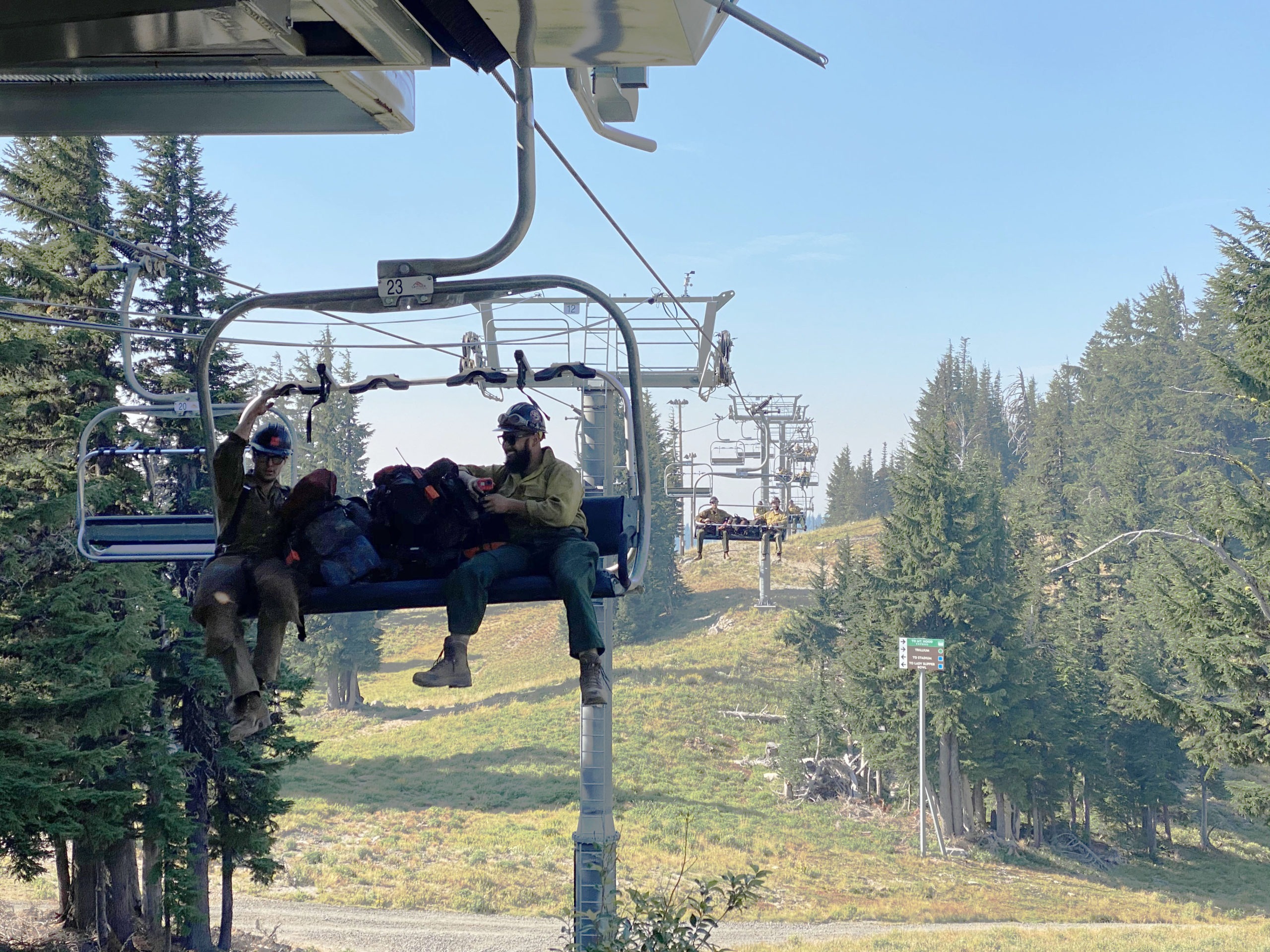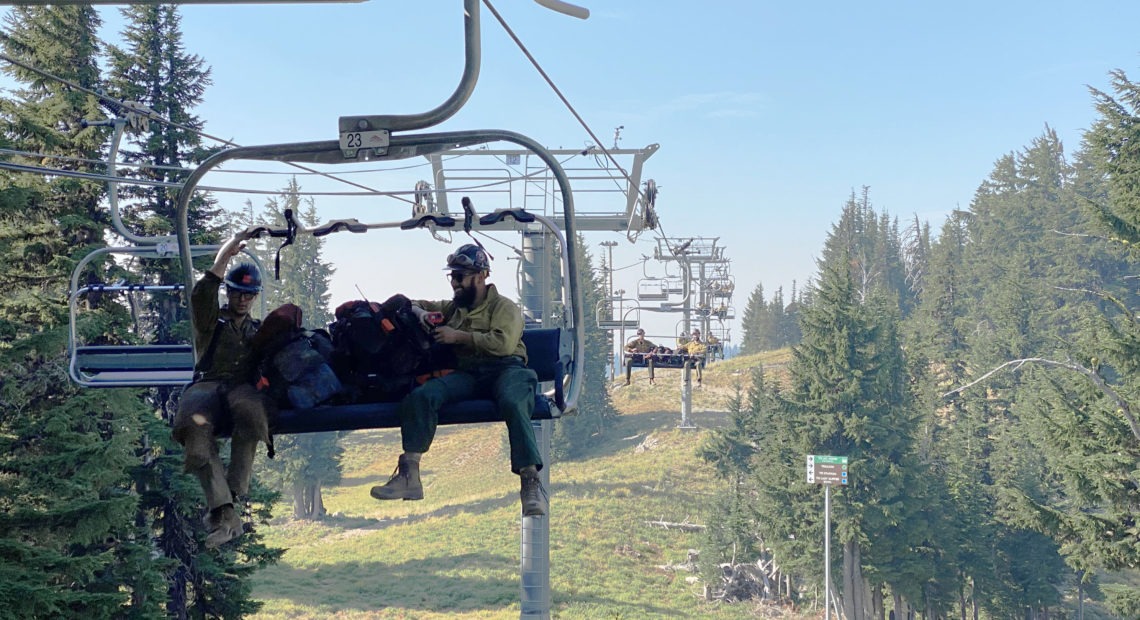
Riding The Ski Lift…To Fire. How Quick Action Helped Mount Hood While Northwest Flames Raged
Listen
Late Monday night, Sept. 14, a fire sparked alongside the winding mountain highway that leads to White Pass, a ski area about 15 miles east of Packwood, Washington.
The fire started a few miles east of White Pass, in steep terrain. A ski area employee traveling U.S. Highway 12 spotted the early flames and reported it.
White Pass mountain manager Russ Forman jumped in the company’s tanker truck and headed to the scene. Photos later posted to Instagram show embers flying, trees in flames and Forman dousing the fire with a hose.
“We tried to keep at bay until the Forest Service arrived. Helped some to keep it contained. When we left they had 3 engines and seemed to be getting it under control,” Eric Schultheiss, who first spotted the fire, posted on Facebook.
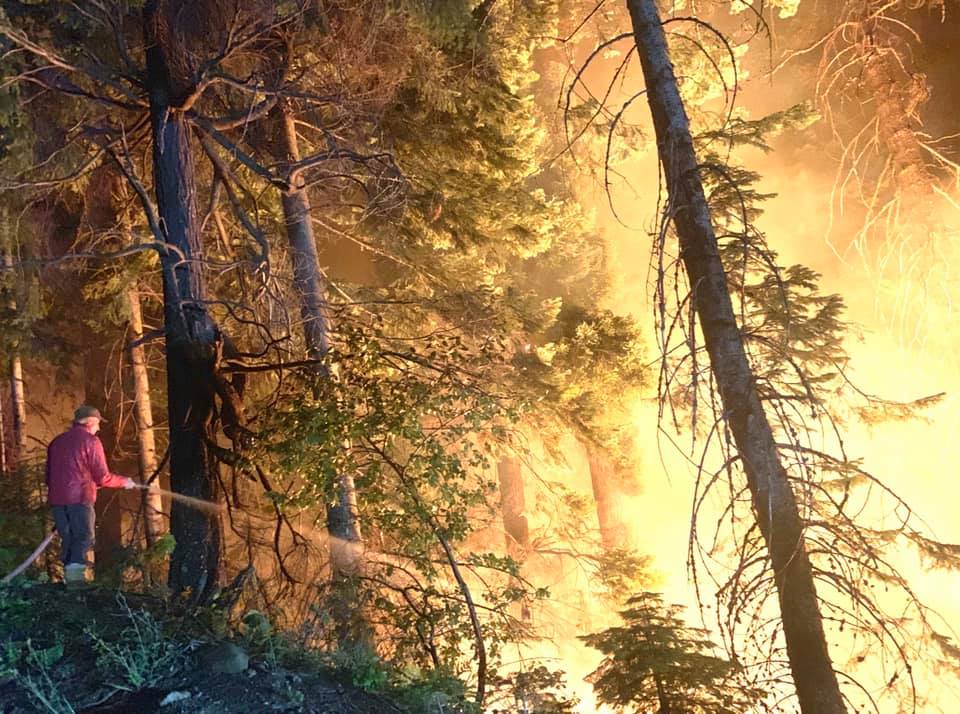
White Pass Ski Area manager Russ Forman fights the early flames of the Cold Creek Fire a few miles east of the ski area along Highway 12 on Sept. 14, 2020. The ski area has its own water tanker trunk and firefighting equipment. CREDIT: Eric Schultheiss via Facebook
As of Friday, the Cold Creek Fire had grown to 400 acres and is still burning in timber and brush, running uphills. Highway 12 remains closed in both directions. Homes around Rimrock and Clear lakes are at Level 2 evacuation – or “be prepared.”
For now, White Pass Ski Area appears to have avoided the flames.
SEE MORE: Wildfire News And Updates From NWPB
But, increasingly severe wildfire seasons – made worse by climate change – are a concern for ski areas, according to Jordan Elliott, president of the Pacific Northwest Ski Areas Association.
“People talk about snowpack and talk about what that might be like for the future of recreation at ski areas. Fires are just another side of that multi-sided coin,” Elliott said.
Ski Areas Prepping
Beyond destroying buildings and lodges, fires could ruin chairlifts. Even if the flames didn’t reach the lifts, the heat could damage the haul rope or the mechanics that make the lifts run.
Elliott says Northwest ski areas are prepping for fires. They’ve got fire plans in place. Some, like White Pass, have their own tanker trucks. Snow-making lines can also come in handy. (More on that later.)
“In terms of the mountain geography, the ski trails, a lot of that stuff is kind of like a fire barrier anway. When the trees are cut down, and the ski trails are there, that helps slow the spread of fires on a ski area, should there be one there,” Elliott said.
Partnering with the Forest Service is also key.
As of 2017, the Forest Service said 122 ski areas were permitted on National Forest land, making up roughly 60 percent of the “total capacity for downhill skiing in the United States.” Downhill skiing and snowboarding were the second only to hiking as the most popular activity in National Forests.
Catching A Fire On Mount Hood
Close communication with the Forest Service helped save one Mount Hood ski resort on Labor Day, when fire danger was critical and fires sparked and grew fast all round the Northwest.
Employees at Mount Hood Meadows saw a social media post of a plume of smoke. They used the ski area’s webcam to confirm that, yes, there was smoke in the Jack’s Woods area of Heather Canyon – a popular spot for advanced powder and tree skiers.
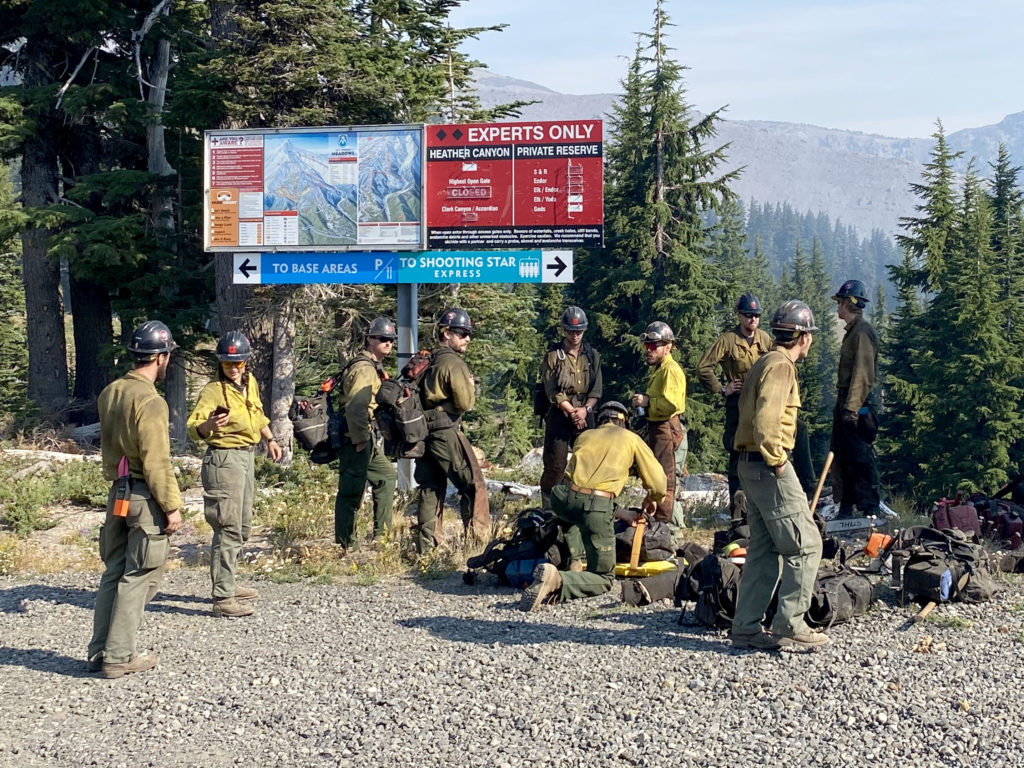
Fire crews had to hike down into Heather Canyon from the top of Mount Hood Meadows’ Stadium Express chairlift. Heather Canyon is an expert’s only part of the ski area. Courtesy of Dave Tragethon / Mount Hood Meadows
It’s double-black diamond terrain. Experts only. It would make for hard hiking in the summer.
Meadows’ general manager Greg Pack made it to the area first, with a fire extinguisher and an axe. Fire crews showed up a short time later, according to Dave Tragethon, Mount Hood Meadows’ vice president of sales and marketing.
It was early in the day, before winds picked up and fanned big fires across the Northwest.
A Sikorsky helicopter started dumping water. Two other helicopters joined and “got 30 different drops, pulling water from (Jean Lake) a high mountain lake that was just a few miles from Mount Hood Meadows,” Tragethon said.
Fire crews took advantage of the fight at a ski area. They took the four-person, high speed Stadium Express chair lift to reach the flames, instead of hiking up the hill and over the ridge.
In another nod to the “multi-sided climate change coin,” ski area staff used their snowmaking equipment to help firefighters. Snowmaking equipment is used to generate more snow in the winter. Now, the lines were helping fight fires.
“Initially, we were able to deploy some of our snowmaking lines to provide the firefighters on the ground a place to charge hoses and get a water source,” Tragethon said.
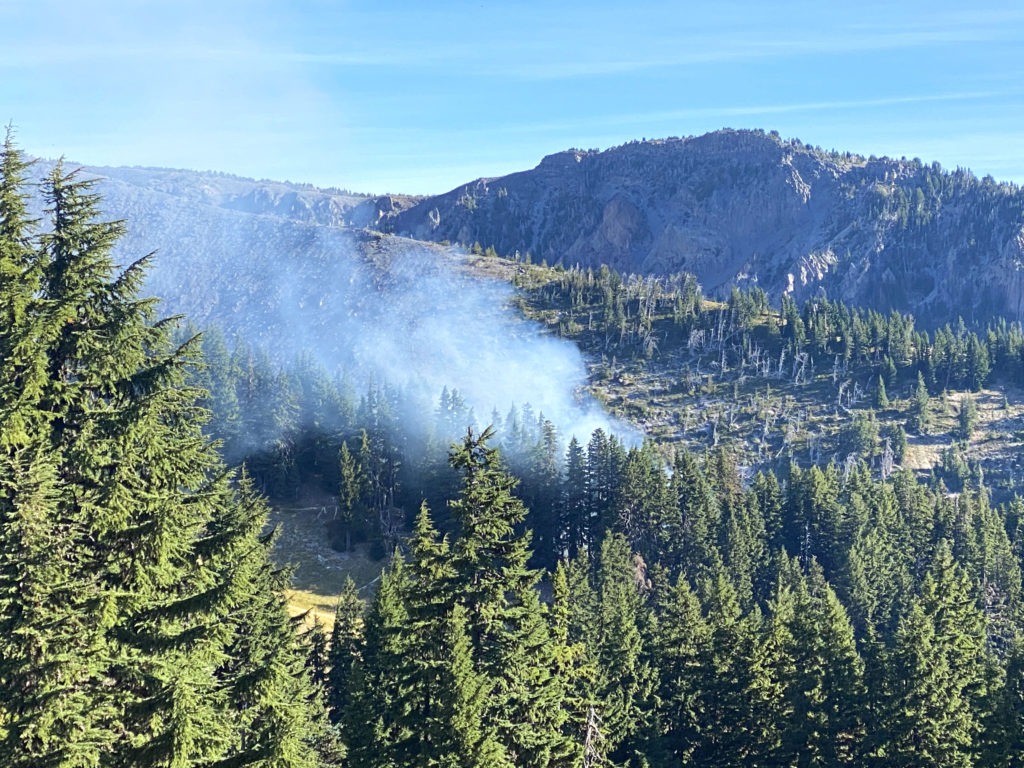
Social media posts alerted Mount Hood Meadows employees to a smoke plume in the Heather Canyon area. They confirmed the plume with the ski area’s webcams. Courtesy of Dave Tragethon / Mount Hood Meadows
Crews moved a tanker truck to a nearby stream so they had a continuous water source. By that time, the winds were too strong for helicopters to fly.
Firefighters kept it to less than two acres. It mostly stayed out of the crowns of trees, Tragethon said. The cause is still undetermined, but it’s thought to have been sparked by an unattended campfire along the Timberline Trail that circles the mountain. (Campfires have been banned in the forest since early August due to the fire hazard.)
“Everybody has to approach the forest with a heightened sense of responsibility. In a situation like this, to have, potentially, the entire (ski) area go up because someone may have left an unattended campfire, that would just be disastrous,” Tragethon said.
Close Call
After the area is cleaned up, Tragethon said it shouldn’t be very noticeable, like it could have been if the fire had really taken off. To make sure that doesn’t still happen, crews continue to sprinkle water and monitor the burn area.
In the wake of this close call, the ski area is looking at getting its own tanker truck, Tragethon said. He said Meadows is also looking at how it can reduce fuel in its forest area, something he says needs to be considered even more as the climate changes.
Fires – and the loss of snowpack – are just “different symptoms of the same disease,” Jordan Elliott with the regional ski area association said.
“In terms of climate change, ski areas aren’t just talking about fires, and aren’t just talking about snowpack – although that’s the biggest thing – and aren’t just taking immediate approaches to help it remain a sustainable business, like snowmaking equipment,” Elliott said. “But just talking about carbon pricing and other ways that climate change is affecting every part of our lives.”
Related Stories:
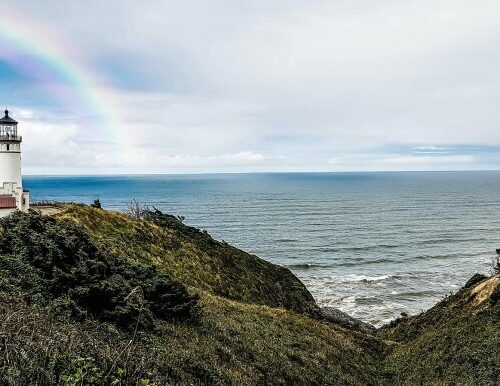
Report To Washington State Parks Commission Shows Barriers For Black Community Outdoors
The Washington State Parks Commission says it wants more Black community members to enjoy the outdoors.
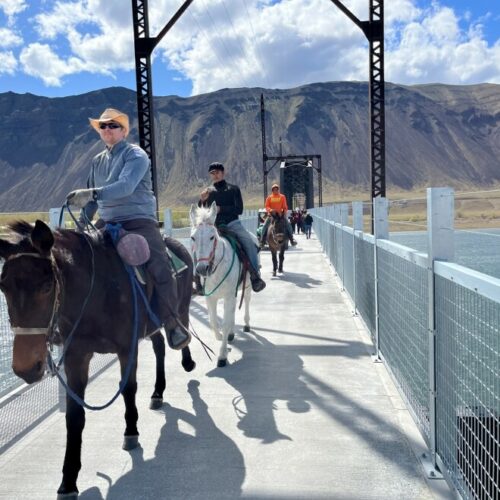
Riding Or Hiking Across Washington State Just Got Easier With New Bridge Over Columbia River
The Columbia River has long divided the two halves of Washington’s cross-state Palouse to Cascades State Park Trail. Now, a rebuilt rail trestle over the river south of Vantage connects the two sides making it easier for cyclists, horse riders and hikers to undertake a spectacular east-west journey.
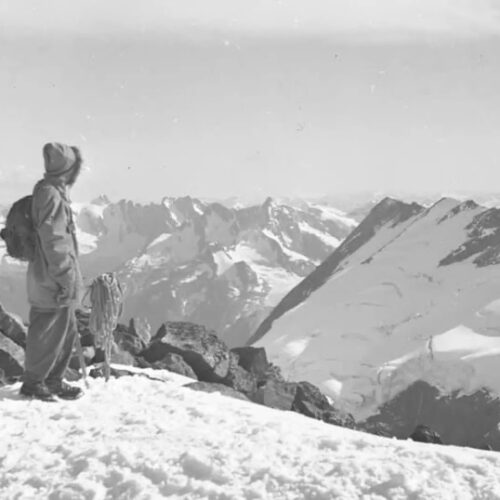
How A Box Of Negatives Led To A Journey Through Northwest Mountaineering History
Reporter Courtney Flatt finds out who is the person in a box of old pictures.

